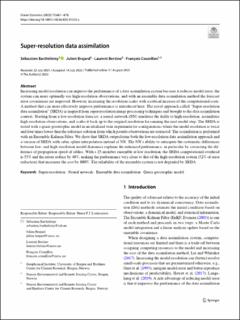| dc.contributor.author | Barthelemy, Sebastien Jean-Claude | |
| dc.contributor.author | Brajard, Julien | |
| dc.contributor.author | Bertino, Laurent | |
| dc.contributor.author | Counillon, Francois Stephane | |
| dc.date.accessioned | 2022-12-29T13:56:12Z | |
| dc.date.available | 2022-12-29T13:56:12Z | |
| dc.date.created | 2022-08-24T15:17:45Z | |
| dc.date.issued | 2022 | |
| dc.identifier.issn | 1616-7341 | |
| dc.identifier.uri | https://hdl.handle.net/11250/3039920 | |
| dc.description.abstract | Increasing model resolution can improve the performance of a data assimilation system because it reduces model error, the system can more optimally use high-resolution observations, and with an ensemble data assimilation method the forecast error covariances are improved. However, increasing the resolution scales with a cubical increase of the computational costs. A method that can more effectively improve performance is introduced here. The novel approach called “Super-resolution data assimilation” (SRDA) is inspired from super-resolution image processing techniques and brought to the data assimilation context. Starting from a low-resolution forecast, a neural network (NN) emulates the fields to high-resolution, assimilates high-resolution observations, and scales it back up to the original resolution for running the next model step. The SRDA is tested with a quasi-geostrophic model in an idealized twin experiment for configurations where the model resolution is twice and four times lower than the reference solution from which pseudo-observations are extracted. The assimilation is performed with an Ensemble Kalman Filter. We show that SRDA outperforms both the low-resolution data assimilation approach and a version of SRDA with cubic spline interpolation instead of NN. The NN’s ability to anticipate the systematic differences between low- and high-resolution model dynamics explains the enhanced performance, in particular by correcting the difference of propagation speed of eddies. With a 25-member ensemble at low resolution, the SRDA computational overhead is 55% and the errors reduce by 40%, making the performance very close to that of the high-resolution system (52% of error reduction) that increases the cost by 800%. The reliability of the ensemble system is not degraded by SRDA. | en_US |
| dc.language.iso | eng | en_US |
| dc.publisher | Springer | en_US |
| dc.rights | Navngivelse 4.0 Internasjonal | * |
| dc.rights.uri | http://creativecommons.org/licenses/by/4.0/deed.no | * |
| dc.title | Super-resolution data assimilation | en_US |
| dc.type | Journal article | en_US |
| dc.type | Peer reviewed | en_US |
| dc.description.version | publishedVersion | en_US |
| dc.rights.holder | Copyright 2022 the authors | en_US |
| cristin.ispublished | true | |
| cristin.fulltext | original | |
| cristin.qualitycode | 1 | |
| dc.identifier.doi | 10.1007/s10236-022-01523-x | |
| dc.identifier.cristin | 2045751 | |
| dc.source.journal | Ocean Dynamics | en_US |
| dc.source.pagenumber | 661-678 | en_US |
| dc.relation.project | Sigma2: NS9039k | en_US |
| dc.relation.project | Trond Mohn stiftelse: BFS2018TMT01 | en_US |
| dc.relation.project | Norges forskningsråd: 270733 | en_US |
| dc.relation.project | Norges forskningsråd: 309562 | en_US |
| dc.relation.project | Sigma2: nn9039k | en_US |
| dc.relation.project | EC/H2020/727852 | en_US |
| dc.identifier.citation | Ocean Dynamics. 2022, 72 (8), 661-678. | en_US |
| dc.source.volume | 72 | en_US |
| dc.source.issue | 8 | en_US |

